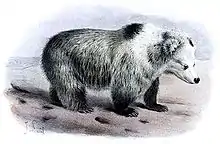Tibetan blue bear
The Tibetan bear or Tibetan blue bear (Ursus arctos pruinosus)[1] is a subspecies of the brown bear (Ursus arctos) found in the eastern Tibetan Plateau. It is also known as the Himalayan blue bear,[2] Himalayan snow bear, Tibetan brown bear, or the horse bear. In Tibetan, it is known as Dom gyamuk.
| Ursus arctos pruinosus | |
|---|---|
 | |
| Scientific classification | |
| Kingdom: | Animalia |
| Phylum: | Chordata |
| Class: | Mammalia |
| Order: | Carnivora |
| Family: | Ursidae |
| Genus: | Ursus |
| Species: | |
| Subspecies: | U. a. pruinosus |
| Trinomial name | |
| Ursus arctos pruinosus Blyth, 1854 | |
One of the rarest subspecies of bear in the world, the blue bear is rarely sighted in the wild. The blue bear is known in the West only through a small number of fur and bone samples. It was first classified in 1854.
Taxonomic history
The Gobi bear is sometimes classified as being of the same subspecies as the Tibetan blue bear; this is based on morphological similarities, and the belief that the desert-dwelling Gobi bear represents a relict population of the blue bear. However, the Gobi bear is sometimes classified as its own subspecies, and closely resembles other Asian brown bears.
Range and habitat
It is possible that the occasional specimen might be observed traveling through high mountain peaks during times of reduced food supply, or in search of a mate. However, the limited information available about the habits and range of the blue bear makes such speculation difficult to confirm.
Conservation status
)_(17540841703).jpg.webp)
The exact conservation status of the blue bear is unknown, due to limited information. However, in the United States trading blue bear specimens or products is restricted by the Endangered Species Act. It is also listed in Appendix I of the Convention on International Trade in Endangered Species (CITES) as a protected species. It is threatened by the use of bear bile in traditional Chinese medicine and habitat encroachment.
)_(17975206579).jpg.webp)
Cultural references
The blue bear is notable for having been suggested as one possible inspiration for the yeti. A 1960 expedition to search for evidence of the yeti, led by Sir Edmund Hillary, returned with two scraps of fur that had been identified by locals as 'yeti fur' that were later scientifically identified as being portions of the pelt of a blue bear.[3][4]
References
- Lydekker P.Z.S (1897). "The Blue Bear of Tibet". Proceedings of the Zoological Society of London. 1897: 412.
- Sowerby, Arthur de Carle (1920). "Notes on Heude's Bears in the Sikawei Museum, and on the Bears of Palaearctic Eastern Asia". Journal of Mammalogy. American Society of Mammalogists: 225.
- "Genève: 15 000 francs pour une peau de yéti"
- Détail du lot n° 872" Archived 2012-03-26 at the Wayback Machine
External links
| Wikispecies has information related to Ursus arctos. |
 Media related to Ursus arctos pruinosus at Wikimedia Commons
Media related to Ursus arctos pruinosus at Wikimedia Commons
